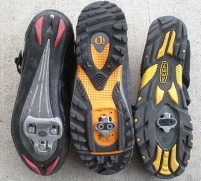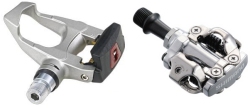Living with hills — Part 2
by post_author );
// If display name is not available then use nickname as display name
if ( empty( $display_name ) )
$display_name = get_the_author_meta( ‘nickname’, $post->post_author );
echo $display_name;
?>
More “Living with hills (and how you can learn to love them)“, part 2 of ?
I had a few questions after the first hills article and I thought answering them would be a good start for this follow on.
Question 1 Some riders seem to stand up when doing hills and some sit in the saddle. Why is that? When should one stand going up a hill? Is there an ideal way (i.e. intermittently sit/stand sit/stand) to shoot for? What are the advantages and disadvantages of standing to climb a hill?
You get the most power generation sitting down and keeping your cadence up (using clips and a good “circle” technique, see #2). However, when you stand up, you do get the added benefit of all your weight pushing down on the pedal — as long as you’re lifting your other leg and not pushing it up too!!
Personally, I haven’t found that standing really gets me going any faster, and takes just as much, if not more, energy and I get winded faster. Even so, standing can give your hamstrings a break. I had a friend who was a very good climber and he mimicked some tour-de-france rider who claimed that changing your hand positions from the drops to the hoods to the top of the handle bars gave you six positions for climbing (those three positions and sitting or standing). He further claimed that each position used slightly different muscles so that you could get some good benefits by switching between them on a climb. Though I was never quite convinced of the theory, he always beat me up the hills. On a long hard climb, I’ll stand about 25% of the way, just for the change. Also, have you ever heard of “the magic shift”? Shift up to a higher gear or two as you’re standing, and shift back to a lower gear as you’re sitting down.
Question 2 Some riders do not have clips, or those straps on their pedals. Does having the right clips help the climb by lifting with one leg while pushing with the other? If using the lifting leg is helpful, what is the best technique?
Yeah, clips (or cleated shoes and “clipless” pedals) help engage more of your leg muscles than your quads — which is what your mostly using if you have just a flat pedal and no clips. Pedaling in a circle is the most effective way to use all of your leg muscles. Practice in a training stand, on a stationary bike, or on a flat section of road. Unclip one leg and try to make a perfectly smooth circle with the other leg. Then switch feet. It’s harder than you think, but a little practice and you’ll be spinning up faster that you can say “Contador!” If you aren’t lifting the leg that’s not providing power, you’re using your other leg to lift it up and using power that would otherwise be delivered to the wheels. Another tip I’ve heard and used is to move your foot like you were scraping mud off the bottom of your shoe using the pedal.
“Clipless”* cycling shoes have a number of advantages over your sneakers. First, the soles are quite stiff and this allows the pressure on your feet to be distributed and not concentrated on the ball of your foot. Secondly, the direct connection between the shoe and the pedal lets you use that upstroke to contribute the power of your hamstrings to the move the cranks. A properly fit cycling shoe along with a proper spinning technique will let you ride farther with less foot fatigue.


Cleats on shoes (left). Clipless Pedals (right).
This is also a good time to talk about cadence. Cadence is the number of revolutions per minute of the cranks (i.e., your feet). Racing cyclists generally have cadences of 80 to 110 RPM. Recreational riders are usually at 60-80 RPM. When you’re climbing a hill, your cadence will drop about 20 RPM and that’s normal. The advantages of keeping a higher cadence is that you are doing those circles using more muscles and that puts less stress on your knee joints. It’s just another factor you can experiment with to get a more comfortable and efficient ride.
*-clipless in the sense that the cage-style pedals that were the first attempt at providing lifting power were called “Clips”. Those were replace by “clipless” in which a cleat on the shoe is “clipped” into the pedal. The terms can be confusing because you “clip-in” with a “clipless” pedal.
Question 3 Should one ‘carb up’ prior to a climb or wait to get hungry?
Long climb coming up? Carb up about 10-20 minutes before you get to the hill. Otherwise, the sugars won’t be digested enough to help you. Shorter climbs? — not really going to help much as you’ll be over them before the sugar boost kicks in. Best to eat a good pre-ride meal with enough time to digest some of the food, since generally, the body will divert resources from digestion to support activity. That time will, of course, vary with individuals and some people may prefer to go out on an empty stomach. Whatever works for you. You can’t do long distances without fuel, however. Intense exercise requires 30-60g of carbohydrates per hour**– you can burn 6000 calories doing a century ride, so don’t neglect your need for calories when you’re out there riding. If you use gels, you’ll need to drink water with them or they’ll just sit there making you feel sluggish.
** – “Life cycle nutrition: an evidence-based approach.” S. Edelstein, J. Sharlin
Question 4 Any tips on clothing for climbing and descent?
Sounds like another article on “Why we wear spandex!” ;) Avoiding the deeper issue of spandex for now, for cycling in general, you want tight fitting clothing to be more aerodynamic and to avoid flapping. If your clothes are flapping, that means you’re catching the wind and that sucks energy from your forward motion, meaning you have to put in more effort to go the same distance as your body glove clad riding partner. You’ll want good clothing that wicks away moisture, too, but I’ll save that for the “Why spandex?” article.
As for what to wear when, well, that’s very unique to individuals, the time of year, and the current weather conditions. I guess I’m being asked about cold weather because in hot weather you just wear as little as you can possibly get away with and not end up in jail. In colder and wet weather, you’ll have to experiment with what works for you. A wise, experienced cyclist once taught me to “go out expecting to be cold for ten minutes or so”. With activity, you’ll warm up soon and if you overdress, the rest of your ride you’ll be uncomfortably hot.” See the Winter Cycling Tips article on this site for some good guidelines for clothing to use in varying conditions (with a good deal of thanks due to the crew at Freeze-Thaw Cycles in State College. Caution: Spandex ahead).


